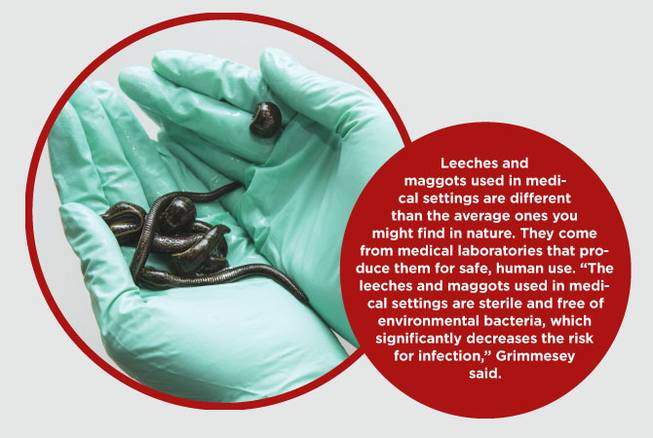
Monday, Dec. 18, 2017 | 2 a.m.
Meet the medical professionals in this story
• Diana Grimmesey, MHA, RN, CWCN, Wound Care and Hyperbarics Director at MountainView Hospital
Leeches and maggots have a long history in medicine.
While the idea of using creepy-crawlies to treat serious medical conditions may seem like a relic of medieval times, they have become an important mainstay in modern biotherapeutical practices. They’re each used to treat several diseases and injuries, and do so with a high success rate.
“Leeches and/or maggots are typically used by surgeons — general, plastic, trauma and orthopedic — as well as physicians specializing in wound care,” said Diana Grimmesey, RN.
From reattaching severed fingers to treating infected wounds, the healing power of leeches and maggots is nothing short of amazing.
Leeches
History
“Leeches have been used in the field of medicine for more than 2,500 years,” Grimmesey said, and they were used consistently throughout until the 20th century. They weren’t reconsidered by most modern physicians until the late 1970s, when leeches began to gain traction as a significant tool for reattaching tissue following traumatic injuries.
How/why they’re used
Leeches are bloodsuckers — they have three jaws with about 100 teeth each, and within their saliva are enzymes that act as natural anesthetics and anticoagulants.
“Their bite produces a number of benefits to the human body in certain circumstances, especially when it comes to venous stasis — a condition where outflow of blood in the vein is congested,” Grimmesey said. “They are also helpful when trying to reattach tissue to the body.”
Because leeches produce an anticoagulant and literally suck blood from the surface of skin, they are often used to revive delicate veins and improve blood flow following a tissue reattachment procedure.
What is the process like?
“A leech is applied to the cleaned area where there is blood congestion and/or an injury,” Grimmesey said. “Their bite has an anesthetic in it, so it’s painless. They’re left on for about 45 minutes, or until they’re fully engorged, and then they’re easy to remove. Another leech may be applied approximately eight hours later, if necessary.”
One leech typically digests about 1.5 ounces of blood with each application, and leech therapy generally lasts three to seven days, with leeches applied two to three times each day.
Example: A patient has a severed fingertip and the surgeon is able to reattach it. However, following the reattachment surgery, blood is not flowing properly to the fingertip because the small veins have collapsed and are unable to carry enough blood to the newly attached tissue. Leeches might be used to help reinstate the veins, and get the blood circulating again.
Maggots
History
According to a 2009 article published in the Journal of Diabetes Science and Technology, the beneficial effects of maggots were observed among military physicians for centuries, but William Baer was the first doctor to test maggots on nonhealing wounds in 1929. Until the 1940s, when antibiotics became readily available, maggots were used by thousands of doctors across the Western world.
Today, as doctors battle an epidemic of nonhealing wounds, and concerns about antibiotic-resistant infections continue to mount, maggots are making an important comeback.
How/why they’re used
Maggots are used to clean wounds that are not healing normally, are infected, or are necrotic (wherein the tissue dies off).
“Wounds that are open longer than one month have a higher risk for developing nonviable tissue in the wound bed, which attracts bacteria and leads to infection,” Grimmesey said. “When maggots are applied to the wound, they secrete an enzyme in their saliva that liquefies nonviable tissue, and then they digest it. The nonviable tissue and the infection are now neatly contained in the maggot’s bodies, and the patient is ready for the next phase of wound healing.”
Maggots often are used for patients who are not good candidates for surgery, or have not responded positively to other types of intervention.
What is the process like?
The wound bed is cleaned and the surrounding tissue is prepped with a thick border of zinc oxide, which prevents the maggots from escaping. Then, maggots are applied to the wound bed.
“We apply about 10 maggots per square centimeter of the wound, and then place a saline damp gauze over the maggots, before placing a dry sterile gauze over the entire area,” Grimmesey said.
Maggots are typically left in place for two to three days, and depending on the wound, some patients may require multiple applications.
Example: A diabetic foot ulcer has left a patient with a deep, nonhealing wound and a serious infection that doctors warn might lead to amputation. Maggots might be applied to the wound to clear out all of the infected and dead tissue, leaving only healthy tissue, which allows the patient to begin the healing process.
How they're regulated
Both leeches and maggots were approved by the FDA in 2004 as a single-use medical device.
Prior to being used, they are kept in safe, sterile containers. Following use, they are immediately disposed of as biohazardous waste.
Leeches and maggots used in medical settings are different than the average ones you might find in nature. They come from medical laboratories that produce them for safe, human use. “The leeches and maggots used in medical settings are sterile and free of environmental bacteria, which significantly decreases the risk for infection,” Grimmesey said.
Did you know?
Grimmesey notes that one of the most common misconceptions about this type of therapy is that the leeches and/or maggots will somehow escape and attach themselves to other places in the body. Don’t worry — this doesn’t happen.
“They are very primitive critters and are driven to constantly eat,” she said. “When they are intentionally placed in a good food source, they don’t leave it.”
